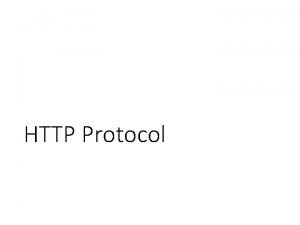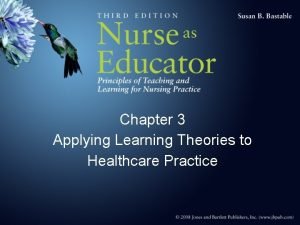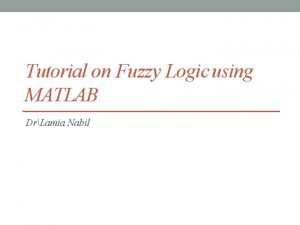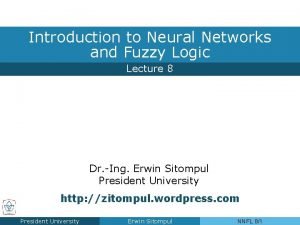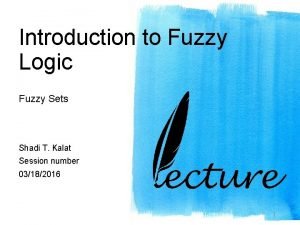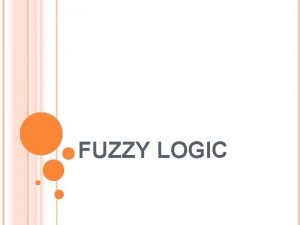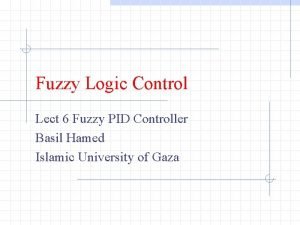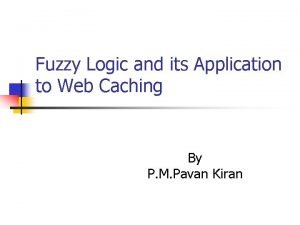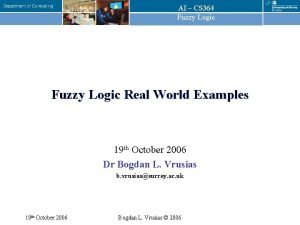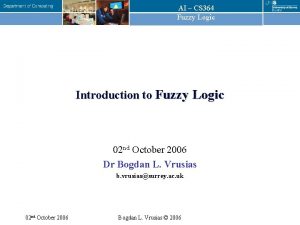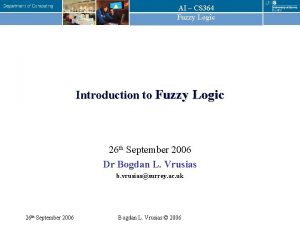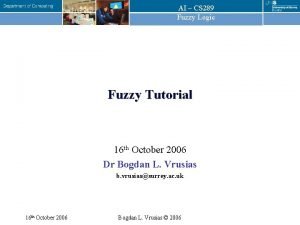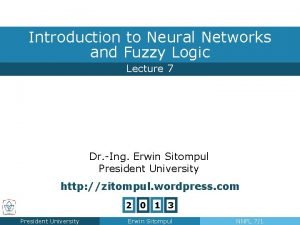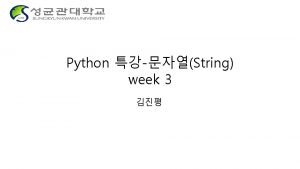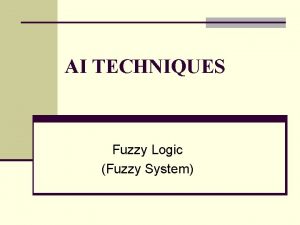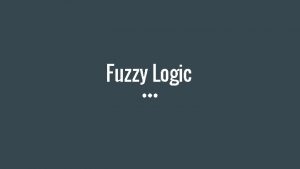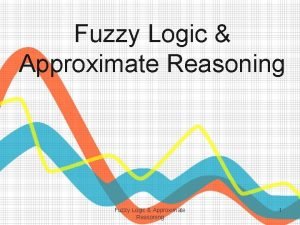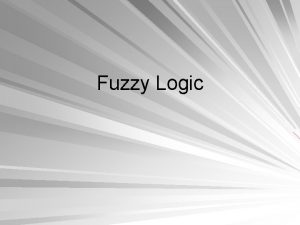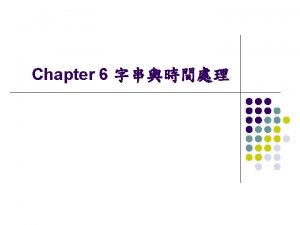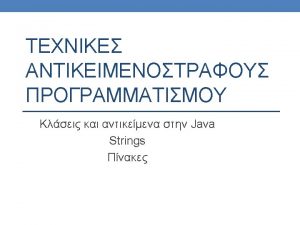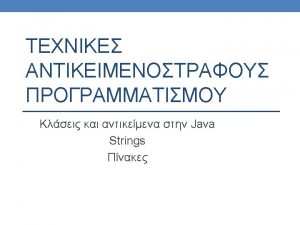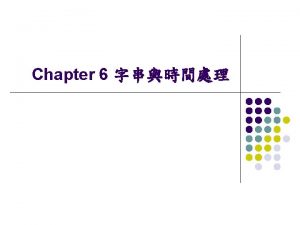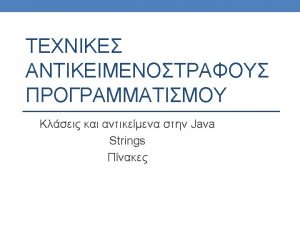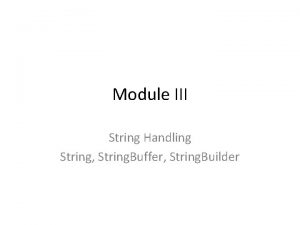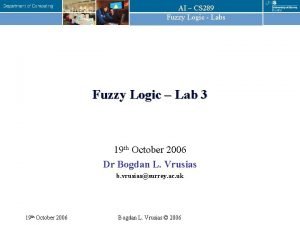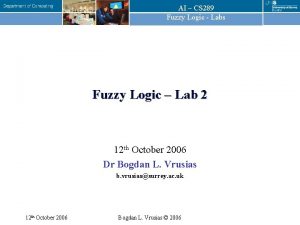String Theories Fuzzy Logic and Forecasting Inconsistencies Applying

















- Slides: 17

String Theories, Fuzzy Logic and Forecasting: Inconsistencies Applying Empirical Plant Disease Models Daniel Cooley and Jon Clements University of Massachusetts Amherst dcooley@microbio. umass. edu UMass. Amherst

Case study: sooty blotch flyspeck complex of apple • Models target period following end of primary apple scab to ~ 1. 5 in. apples • Can eliminate several early summer fungicide ‘cover’ applications Scab fungicides: green tip to fruit set 1 to 4 applics. 3 to 6 applics. SBFS fungicides: fruit set to harvest UMass. Amherst

Basic concept • Most or all SBFS inoculum develops on reservoir hosts in borders and moves into orchards • Development in borders and on fruit is driven by surface moisture or very high humidity • FS is focus UMass. Amherst

Original model • Brown & Sutton 1995 – empirical model based on first signs • Biofix – 10 days after petal fall • 273 accumulated leaf wetness hrs. for periods ≥ 4 hrs. UMass. Amherst

Original model – LW sensing • De. Wit monitor – “string” based • Wet if ≥ 50% deflection • Placed inside dripline of tree • 1. 5 meter above ground UMass. Amherst

Original model action threshold • First appearance of signs: 209 to 310 ALWH • Benzimidazole trt. at 200 to 225 ALWH • “… the threshold that we have established with the de. Wit sensor may have to be modified if other sensors are used. ” UMass. Amherst

Hartman revision • Electronic sensor rather than de. Wit • Used a 175 hr. treatment threshold • Counted all wet hrs. – no 4 hr. minimum • Biofix of the first postpetal fall fungicide treatment UMass. Amherst

Illinois / Iowa / Wisconsin • Babadoost et al. 2004 used Hartman modification • Compared electronic on-site with mesoscale interpolated (Skybit) data • Skybit LW accumulated more rapidly than on-site • SBFS Incidence higher in modeldirected plots in 12 of 28 site yrs. UMass. Amherst

LW vs. RH • Duttweiler et al. 2008 • Accumulated hrs. of RH ≥ 97% better predictor in IA, but ALWH better in NC • Regional differences in climate expected with empirical model UMass. Amherst

What does a user ask? • When should I spray? • Commercial model software and monitoring software bundle – Spectrum • Commercial remote monitoring and model delivery – Sky. Bit • Public web-based weather and model delivery – NEWA and Orchard Radar • On-site monitoring and published Extension recommendations UMass. Amherst

Accumulated Leaf Wetness or High RH Hours First SBFS recs. , 5 models 400 350 Orchard Radar using Sky. Bit LW, temp. adj. 270 threshold Jun 6 300 250 Sky. Bit model, 350 threshold Jun 16 Spectrum model, Ext. rec. , 300 threshold on-site Hobo Jul 17 270 threshold Jun 12 NEWA, on-site Hobo 170 threshold Jun 2 200 150 100 50 5 wks. 2 – 3 fungicide applications PF 0 5/3/06 5/10/06 5/17/06 5/24/06 5/31/06 6/7/06 Date 6/14/06 6/21/06 6/28/06 7/5/06 7/12/06 UMass. Amherst

Key differences • Biofix • Petal fall (cultivar? ) • 10 days after petal fall • Last fungicide targeting scab • Accumulated leaf wetness hrs action threshold • Count all hours or exclude short periods • Choose one: 170, 200, 259, 270, 300, 350 … UMass. Amherst

Key differences • Method of data collection • On-site • Remote site-specific • On-site • Placement of grid • 45º facing north 1. 5 meters • Canopy or open? • Is anyone still using strings? • Grid sensitivity: 40% of range? UMass. Amherst

Key differences • Remote site-specific • Sources of data – leaf wetness not common • Algorithms for location • Algorithms to interpolate from common data such as RH and wind speed to LW • Should we just use RH? UMass. Amherst

Accumulated Leaf Wetness or High RH Hours Comparing four data sources Date UMass. Amherst

Issues to resolve • Biofix – last primary scab fungicide vs. phenology • If fungicide, depletion should be used • Differentiate action threshold from damage threshold, i. e. first SBFS fungicide trigger from first visible signs on non-sprayed fruit UMass. Amherst

Issues to resolve • Standardize sensor placement for on-site equipment considering ease of use and maintenance (not in canopy) • Standardize sensor wetness threshold • Determine accurate LW estimators for off-site sensing UMass. Amherst
 Fuzzy sets and fuzzy logic theory and applications
Fuzzy sets and fuzzy logic theory and applications Licenseid=string&content=string&/paramsxml=string
Licenseid=string&content=string&/paramsxml=string Cognitive learning theorist
Cognitive learning theorist Applying learning theories to healthcare practice quizlet
Applying learning theories to healthcare practice quizlet Fuzzy logic lecture
Fuzzy logic lecture Tipping problem
Tipping problem Contoh penerapan logika fuzzy dalam kehidupan sehari hari
Contoh penerapan logika fuzzy dalam kehidupan sehari hari Fuzzy logic lecture
Fuzzy logic lecture Bounded sum in fuzzy logic
Bounded sum in fuzzy logic Fuzzy logic definition
Fuzzy logic definition Fuzzy logic controller
Fuzzy logic controller What is linguistic variables in fuzzy logic
What is linguistic variables in fuzzy logic Mfs
Mfs Fuzzy logic examples from real world
Fuzzy logic examples from real world The washington fuzzy cs
The washington fuzzy cs What is linguistic variables in fuzzy logic
What is linguistic variables in fuzzy logic Fuzzy logic tutorial
Fuzzy logic tutorial Logic sitompul
Logic sitompul

